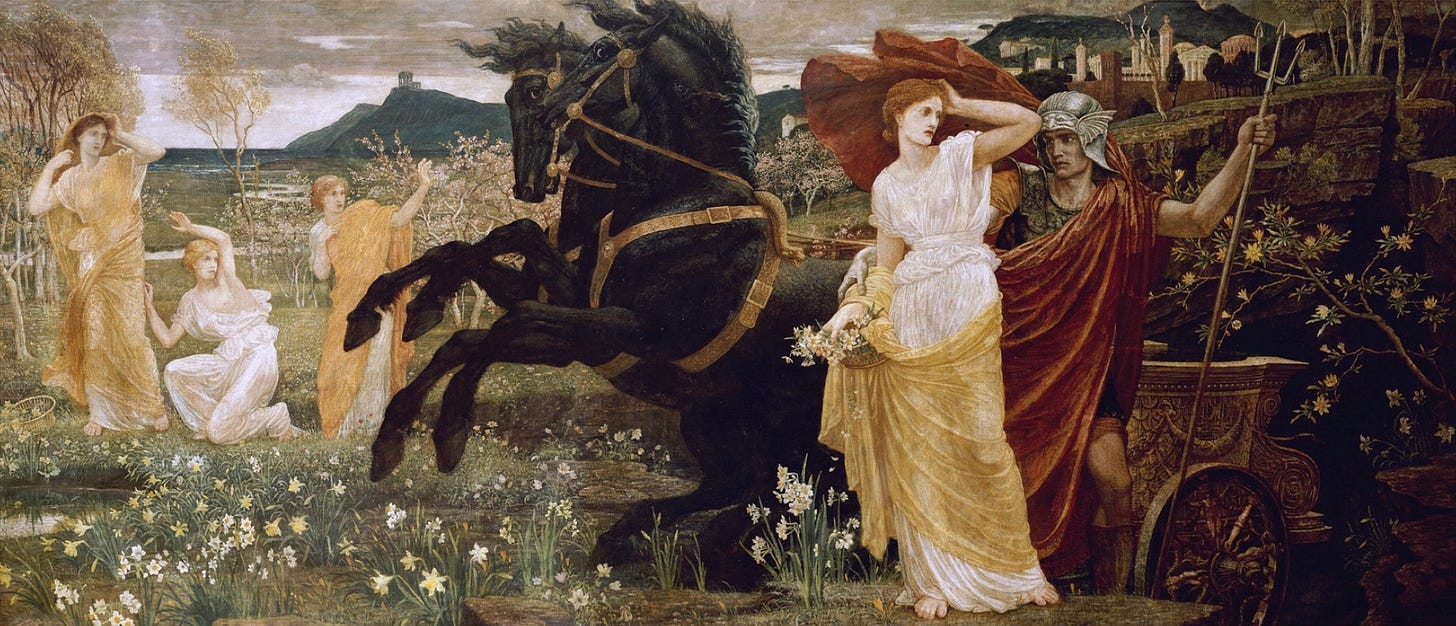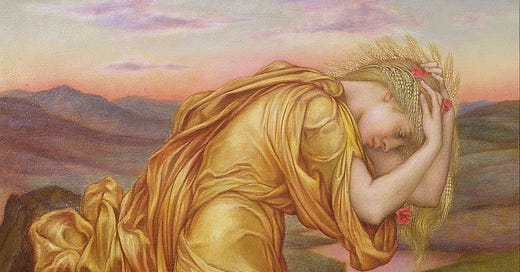Twelve: The Mysteries of Eleusis
ABML examines an ancient archeological puzzle. First of three parts

Eighteen kilometres north of Athens, in a coastal town called Eleusis, lies the sunbaked rubble of an ancient temple. Huge, broken columns hint at the site’s once-impressive architecture. This site was the focus of religious ceremonies extending across two millennia, from approximately 1500 BC to 400 AD.
The Eleusinian Mysteries have lived up to their billing, with details of the ceremonies remaining hidden. In Ancient Greece, publicly sharing particulars of the initiations was an offense punishable by death or banishment. Today’s scholars of ancient history are left with scattered testimony and tantalizing clues. Educated guesswork is required caulk up the capacious cracks in our knowledge of Eleusis.
What scholars do know is this: the ceremonies at Eleusis were held in honour of the fertility goddess Demeter and her daughter Persephone. Initiation rites were open to all members of Hellenic society, men and women, slave or free, as long as they spoke Greek and had never been convicted of murder. The mysteries consisted of two main sets of ceremonies, known as The Lesser Mysteries, which took place in the Spring, and the Greater Mysteries, which took place in the Fall.
Completion of the first set was required before beginning the last set, and they weren’t cheap. The fee for initiation was said to be fifteen drachmas, the equivalent of about ten days wages in the Athens of fourth Century BC - about the same price in today’s money as front row seats to a Taylor Swift concert, or some other wallet-nuking stadium act.
There were four groups of people involved in the rites: priests and priestesses, initiates undergoing the rituals for the first time, those who had previously participated, and ‘those who had seen’ (epoptes), having previously attended The Greater Mysteries and witnessing an unutterable truth.
Just prior to the ceremonies, initiates into the Greater Mysteries drank a brew known as Kykeon. Scholars have good reason to believe it was made from barley and mint. Was there also a psychoactive ingredient as well? We will return to this particular mystery later.
The 18th century translator and Neoplatonist Thomas Taylor believed "the dramatic shows of the Lesser Mysteries occultly signified the miseries of the soul while in subjection to the body, so those of the Greater obscurely intimated, by mystic and splendid visions, the felicity of the soul both here and hereafter, when purified from the defilements of a material nature and constantly elevated to the realities of intellectual [spiritual] vision."
“Mysteries were initiation rituals of a voluntary, personal, and secret character that aimed at a change of mind through experience of the sacred,” wrote historian Walter Burket in Ancient Mystery Cults. Participants were allowed to speak of the general effect of the ceremonies upon them, but not the particulars of rites themselves, leaving scholars a few clues to work with.
After his initiation at Eleusis, the Greek philosopher Sophocles put it this way: “Thrice-happy are those mortals, who, having seen those rites depart for Hades; for to them alone is it granted to have true life there; to the rest all there is evil.” Pindar the poet echoed this sentiment: “Happy is he who, having seen these rites, goes below the hollow earth; for he knows the end of life and he knows its god-sent beginning.”
According to Plato, “The ultimate design of the Mysteries … was to lead us back to the principles from which we descended … a perfect enjoyment of intellectual [spiritual] good.”
Archaeologist George Mylonas was among the many scholars who recognized the significance of these ceremonies for Ancient Greeks:
We cannot help but believe that the Mysteries of Eleusis were not an empty, childish affair devised by shrewd priests to fool the peasant and the ignorant, but a philosophy of life that possessed substance and meaning and imparted a modicum of truth to the human soul. That belief is strengthened when we read in Cicero that Athens has given nothing to the world more excellent or divine than the Eleusinian Mysteries. Let us recall again that the rites of Eleusis were held for some two thousand years; that for two thousand years civilized humanity was sustained and ennobled by those rites. Then we shall be able to appreciate the meaning and importance of Eleusis.
So this was neither an esoteric exercise for a few select converts, nor a paint-by-number sermon for half-hearted believers. So what was it? Although Hellenic lips were sealed on the finer points, a range of ancient authors have left us enough information to permit a broad outline of their content and purpose, notes William A. Savage in Theosophical Society talk:
There were five degrees, according to 6th century Neoplatonist Olympiodorus. The first two involved ritual purification. The third degree consisted of ceremonies to prepare the initiate. The fourth degree was the lesser mysteries, dedicated to Persephone, and the successful participant was called mustēs, one initiated. The fifth degree was the greater mysteries of Demeter, and the successful initiate was called epoptes, one who has seen. A candidate who failed to obtain one of the degrees had to enroll in up to five stages of purification and preparation before continuing to the next degree.
It’s said there were three essential stages of the ceremonies conducted in a great hall called the Telesterion. The were referred to as things done (dromena), things shown (deiknumena), and things seen (legomena). The first was a dramatic reenactment of the Demeter/Persephone myth. The second involved a display of sacred objects. The third involved commentaries on the second stage.
These three stages in combination were known as “unrepeatables” (apporrheta), and as I mentioned, the penalty for divulging their details was death. Cicero and Athenagoras held that the Greek poet Diagoras was condemned to death in Athens for just this crime. The playwright Aeschylus is said to have been prosecuted for revealing secrets of the Mysteries in several of his plays, though he was acquitted.
This is why so very little is known about what initiates actually did at Eleusis: the penalty did the initial work in keeping ancient lips sealed. The later Christian destruction of the pagan world succeeded in eliminating any stray documentation.
A mother in search of her daughter

The Ancient Greek agrarian myth of the Goddess Demeter’s search for her daughter Persephone is a beautiful rendering of harvest and reaping, loss and redemption, mother and daughter. This myth was central to Eleusis, and we can further tease out some content and meaning of the Mysteries by examining it in detail.
The oldest source of the tale is the Homeric Hymn to Demeter, dated around the 7th century BCE, which can be summarized as follows:
Young Persephone, assigned the task of painting all the flowers on Earth in bright colours, is playing in a meadow when she comes across a beautiful narcissus flower. When she reaches for it, the ground gave way and the Lord of the Underworld, Hades, appears before her. He carries her off in his golden chariot with her screaming to Zeus and the Gods of Olympus for help. Hearing the commotion, her mother Demeter rushes to the area. Finding nothing, she wanders the earth grieving for nine days, and on the tenth appeals for help to the Sun, who tells her that Zeus had given his brother Hades permission to take possession of Persephone as his wife.
Furious and filled with grief, Demeter casts off all signs of her divinity and materializes as an old woman, wandering undetected in search of her daughter. At Eleusis she sits near a well, weeping. Four young women offer to help, and with their mother’s permission bring Demeter home. When she steps onto the threshold, a heavenly light fills the room. The family is filled with amazement and fear, but do not cotton on to the old woman’s true identity as a Goddess.
The mother offers Demeter a goblet of wine, but she refuses, requesting instead a drink of barley, water and mint (this would become incorporated into rites of Eleusis as the beverage Kykeon).
Eventually, in an altercation with the mother, the old woman reveals herself as a goddess. She asks the people of Eleusis to build a great temple in which she would instruct them in her ceremonies. Upon completion of the shrine, Demeter sits grieving for her lost daughter. The arrival of spring brings only fallow fields, as the heartbroken Goddess of fertility had robbed seeds of the power to sprout.

Taking notice of this dangerous threat to humanity, Zeus sends down Gods to meet with her, but Demeter ignores them all, wanting only to see her daughter again. Exasperated, Zeus finally dispatches Hermes to the Underworld, who petitions Hades to release Persephone. Hades acquiesces and Hermes leads the girl back to the world above. Demeter rushed joyfully toward her daughter, and immediately asks if she had eaten anything while in the underworld. Alas, Hades had tricked Persephone into eating some pomegranate seeds; and it’s a rule of the Fates that anyone who consumes food or drink in the Underworld must remain there for eternity.
However, an agreement is reached, and as a result Persephone is fated to spend only a third of of every year with Hades as Queen of the Underworld, and the rest of the year among the Gods of Olympus. A relieved Demeter reactivates the divine power that allows seeds to sprout and create the harvest humans depend on. And just before returning to the sunlit pantheon of gods, she instructs the people of Eleusis in the sacred mysteries to honour Her. Every year since this event, Persephone has to return to the Underworld, and every year her mother neglects to cultivate the earth out of sadness.
More on this myth of darkness and light, and its possible meaning for the participants in the Mysteries, in the next part.



